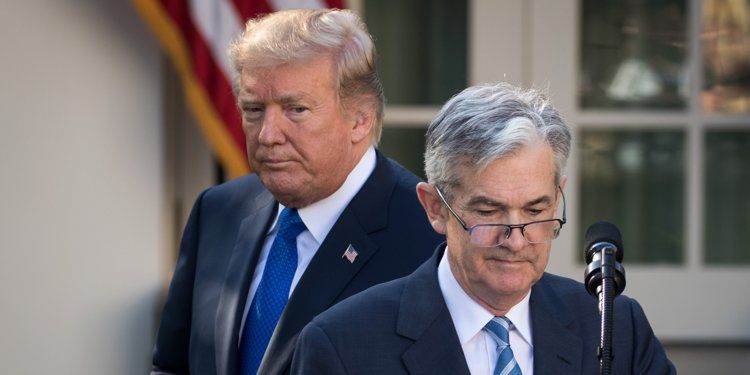
It’s been a challenging few days for financial markets, as traders attempt to interpret last week's latest Twitter rants from US president Donald Trump, after he ordered US companies to leave China and find other markets. The president also berated US Federal Reserve chair Jay Powell after his Jackson Hole speech, by asking whether Jay Powell or Chinese leader Xi Jinping poses the greatest threat to the US.
President Trump also announced an increase in tariffs on $250bn of Chinese goods to 30%, while the 10% tariff amount due to kick in on 1 September on $300bn of Chinese goods has increased to 15%.
This explosive and quite frankly rather unhinged outburst came soon after China imposed tariffs on $75bn of US goods, and Fed chair Jay Powell quite reasonably suggested that there was little the Fed could do to ameliorate tensions caused by the ongoing US-induced uncertainty over trade policy.
In the wake of Friday’s events, stock markets closed the week sharply lower, also sending the Chinese yuan to a new low. The tone then changed again after President Trump claimed over the weekend at the G7 that China had asked to restart trade talks, helping fuel a rally in the US and Asia at the start of this week as investors continue to ride a rollercoaster of uncertainty against a backdrop of speculation about the state of mind of the US president.
The claim that China wants a trade deal helped fuel yesterday’s rebound in US stocks, however the rally was half-hearted at best. The claim doesn’t appear to have been verified from the Chinese side, however even if it had been, its hard to believe that any progress will likely be made to stop the continued escalations
Gold prices made new six-year highs yesterday, while US treasury yields continued to slide further, though they did rebound a touch on Trump’s weekend comments. However the direction of travel seems clear, with markets looking to price in further easing from the Federal Reserve, as fears grow that the US economy will eventually feel the chill winds blowing in from elsewhere in the global economy.
As if to reinforce how the current trade uncertainty is affecting the global economy and Europe in particular, yesterday’s German IFO survey posted its worst reading since 2012, at 94.3, while previous months were downgraded as well. The IFO went on to warn that the slowdown in Germany was now starting to seep into the services sector, with all the risks that could mean any meaningful recovery for Europe’s largest economy. This morning’s final Q2 GDP numbers are expected to confirm that Germany’s economy contracted by 0.1%, with the manufacturing sector the main drag on economic output.
Against such a backdrop the US consumer has thus far remained remarkably resilient, however that could change given recent events. In July consumer confidence hit its highest level this year at 135.7, after a fairly weak reading in June, as US pay and jobs growth continued to improve. This confidence could have taken a hit in August after President Trump upended financial markets by announcing tariffs on the remaining $300bn of Chinese goods from 1 September. A slide to 130.00 is expected, though it wouldn’t be a surprise to see a bigger fall.
EUR/USD – continues to look soft, despite the move up to 1.1170 and as such could well slip back to retest the lows at 1.1020, and on towards the 1.0800 area. Key resistance sits at the 50-day MA at 1.1200 as well as the 1.1250 area.
GBP/USD – broke above the 1.2230 area pushing up to the 1.2285 area in the process, opening up the prospect for further gains. A break through 1.2300 opens up the prospect of a push towards the 1.2400 area. Support remains down the recent two-year lows at 1.2015, and while above the pound looks vulnerable to a move higher. We still have major support sitting at the 1.1980 area.
EUR/GBP – the weekly reversal from a couple of weeks ago has seen the slide back to the 0.9025 area. To see further losses we need to hold below the 0.9180 area, and look for a move through the 0.9000 area towards the 0.8920 area.
USD/JPY – resistance at the 107.00 area remains intact, with a break above the 107.20 level arguing for a move back to the 108.20 area. We still remain vulnerable to a move towards the flash crash lows this year at 104.70, while below 107.20.
Disclaimer: CMC Markets is an execution-only service provider. The material (whether or not it states any opinions) is for general information purposes only, and does not take into account your personal circumstances or objectives. Nothing in this material is (or should be considered to be) financial, investment or other advice on which reliance should be placed. No opinion given in the material constitutes a recommendation by CMC Markets or the author that any particular investment, security, transaction or investment strategy is suitable for any specific person. The material has not been prepared in accordance with legal requirements designed to promote the independence of investment research. Although we are not specifically prevented from dealing before providing this material, we do not seek to take advantage of the material prior to its dissemination.






















